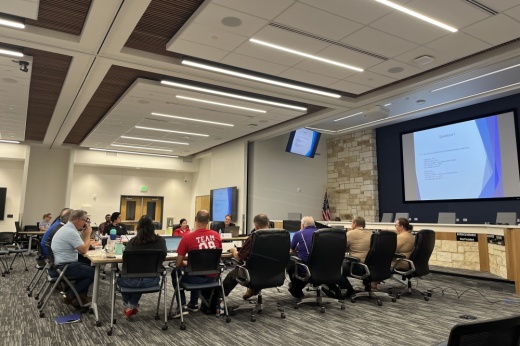Chief Financial Officer Randy Rau held a budget workshop with the board of trustees June 6 to discuss the projected $6.2 million shortfall.
Breaking it down
Rau explained that about 97% of the district’s revenue comes from either local property taxes or state foundation revenue. With an estimated $232.2 million worth of revenue and $238.5 million worth of expenditures, Rau is projecting a $6.2 million shortfall in FY 2024-25.
Rau said the district’s 2024 fund balance, or its savings account, of $30.4 million will end up at $24.1 million with the shortfall. This is about $35.4 million short of the board’s fund balance requirement, which looks to keep a balance that is about 25% of its expenditures.
District data shows the fund balance hit $71 million in 2021 but has continued to decline since.
“We really had the discussion of, ‘Do we really just want to leave [the money] in [the fund balance] when our kids need the services more than ever coming out of the pandemic, or do we want to spend it?’” Superintendent Eric Wright said. “We chose to spend it at the time, and that served us well, and I think we took care of our kids, and we took care of our staff the way that we needed to. Now we’re at a place where we really can’t go any further. ... We need to start going the other way and actually start building [the balance] back up.”
Per Rau’s budget assumptions for expenditures, the district is looking to spend:
- $500,000 to adjust salary compression issues
- $1.1 million for a cost-of-living adjustment for teachers, librarians, nurses and counselors
- $1.3 million to maintain a no-cost insurance option for staff, which will increase the district’s contribution to $445 a month per employee enrolled in benefits
While repurposing and reassigning does not mean job cuts, trustee Geoff Seibel said he doesn’t want to minimize what this could mean for staff.
“These campuses are family,” Seibel said. “It’s hard when we move staff to other campuses. They’re leaving their family, they feel like. We understand that. It’s not just as simple as, we’re moving people from another place so they can get a job and be happy. ... People are doing this professionally because they are passionate about kids and passionate about our community. It’s not just as simple as ‘having a job.’”
How we got here
Wright said there were hopes that new dollars would be brought into the district following the 88th Texas Legislature in 2023, as the state had $4.5 billion earmarked for public education. However, he said it was “held hostage” as the state wasn’t able to come to a consensus on school vouchers.
The basic allotment for Texas public schools—or how much a district gets paid per student—has not increased from $6,160 since 2019. However, Wright said the inflation index has grown around 22% in those five years, the highest the district has experienced without an increase in funding.
“If we just added $500 to the basic allotment, ... that would mean $11 million extra for us,” Wright said. “If it went up $1,000 per kid, it would be $22 million extra for us. If it was where it’s supposed to be at $7,588 a kid, it would mean $33.5 million.”
In response, school districts across the state are gearing up for the next legislative session in January and submitting a list of funding priorities to the Texas Association of School Boards to leverage at the session.
Dates to know
- June 24: The board will hold a public hearing on and adopt the FY 2024-25 budget and compensation plan.
- July 25: The district will receive its certified values from Hays, Travis and Caldwell counties’ appraisal districts.
- Aug. 26: The board will approve the ordinance to set the tax rate.





